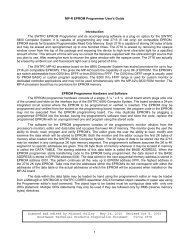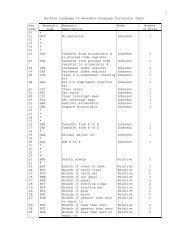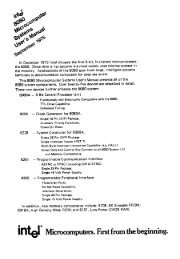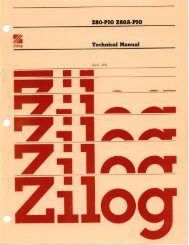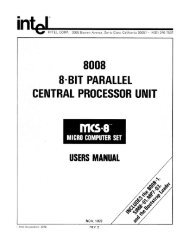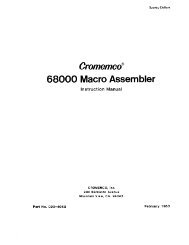The System Manual of SOL-20 - History of Computers
The System Manual of SOL-20 - History of Computers
The System Manual of SOL-20 - History of Computers
Create successful ePaper yourself
Turn your PDF publications into a flip-book with our unique Google optimized e-Paper software.
PROCESSOR TECHNOLOGY CORPORATION<br />
Sol THEORY OF OPERATION<br />
SECTION VIII<br />
Returning to the SDI UART, we see that its transmitter output<br />
on pin 25 is applied to pin 5 <strong>of</strong> U55, a two-input NAND gate that is<br />
functionally a NOR gate. It is normally enabled on pin 4 by pull-up<br />
resistor R44. A low on pin 5 represents a binary 0; a high represents<br />
a binary 1. <strong>The</strong> inverted output on pin 6 <strong>of</strong> U55 is again<br />
inverted (assuming Sol is not operating in Local) by the following<br />
U55 NAND gate. One-half <strong>of</strong> operational amplifier U56, operating open<br />
loop, converts TTL levels to RS-232 levels (5 to 15 volts). Pin 3 <strong>of</strong><br />
U56 is held at +2.5 V dc by the R47 and R48 divider network. When<br />
pin 2 is more negative than pin 3, the output on pin 1 <strong>of</strong> U56, which<br />
is fed to pin 2 <strong>of</strong> J1, is at approximately +10 volts. For the opposite<br />
condition, pin 2 <strong>of</strong> J1 is about -10 volts. Thus, U56 also<br />
inverts, and a high or low on pin 2 <strong>of</strong> J1 represent a binary 1 and 0<br />
respectively.<br />
Two conditions can override transmitted data: a keyboard<br />
break (!BRK) or local (!KBD_LOC) command. For a break command, !BRK on<br />
pin 4 <strong>of</strong> J3 and pin 4 <strong>of</strong> NOR gate U55, is low to hold pin 6 <strong>of</strong> U55<br />
high for the duration <strong>of</strong> the !BRK signal. This appears as a "space",<br />
or high level, on pin 2 <strong>of</strong> J1. (A space, or break, condition requires<br />
that the space level exist for a period longer than the normal<br />
length <strong>of</strong> a character.) In the case <strong>of</strong> a !KBD_LOC command from the<br />
keyboard, pins 1 and 13 <strong>of</strong> the other two U55 sections are low. Thus,<br />
data cannot be transmitted to pin 3 <strong>of</strong> NAND gate U55, and pin 11 <strong>of</strong><br />
NOR gate U55 is held high to enable tri-state driver U37 at pin 15.<br />
Data on pin 6 <strong>of</strong> U55 is consequently looped back by way <strong>of</strong> U37 and<br />
R21 to pin 12 <strong>of</strong> U38. Data on pin 12 <strong>of</strong> U38 overrides any data arriving<br />
at pin 13 <strong>of</strong> U38. In local operation, therefore, data from<br />
pin 25 <strong>of</strong> the UART does not appear at pin 2 <strong>of</strong> J1, but it is looped<br />
back to the receiver input (pin <strong>20</strong>) <strong>of</strong> the UART via U37, R21 and U38.<br />
Notice that data on pin 25 <strong>of</strong> the UART will also be looped<br />
back if S4-6 is closed (half duplex operation). But in this case,<br />
data from the UART is also fed to pin 2 <strong>of</strong> J1.<br />
Serial data from the UART that appears at pin 1 <strong>of</strong> U56 also<br />
drives transistor Q1 by way <strong>of</strong> R45 and R46 to supply the serial current<br />
loop output (SCLO) on pin 11 <strong>of</strong> J1. Q1 supplies <strong>20</strong> ma. (max.)<br />
current for a binary 1 and no current for a binary 0.<br />
Pin 23 <strong>of</strong> J1 (connected through R23 to +12 V dc) is the<br />
serial loop current source (SLCS). It can supply up to <strong>20</strong> ma <strong>of</strong><br />
current to ground and is used when the external current loop device<br />
has no current source.<br />
Data received from a current loop device enters Sol on pins<br />
12 and 13 <strong>of</strong> J1 in the form <strong>of</strong> no current for a 0 and <strong>20</strong> ma <strong>of</strong> current<br />
for a 1. This input is rectified by bridge rectifier D3-D6 and<br />
applied to a light emitting diode (LED) in optical isolator U39. As<br />
its name implies, U39 electrically isolates the current loop circuit<br />
from the rest <strong>of</strong> the Sol. (This isolation permits a high <strong>of</strong>fset<br />
voltage on pins 12 and 13 <strong>of</strong> J1.) For a 1, the LED is energized, and<br />
VIII-21



